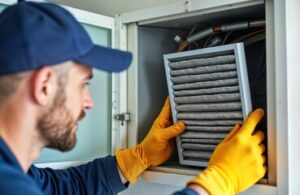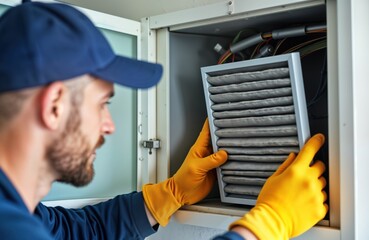Furnaces need to be cleaned regularly. Air moves through a complicated system of returns, ducts and the heat exchanger, picking up dirt, cooking fumes, pet hair, cleaning overspray and more along the way.
A dirty furnace circulates this grime around the home, causing allergy and respiratory problems. Contact Furnace Cleaning West Chester for professional help.
When a furnace burns fuel to produce heat, the combustion process generates soot and other pollutants. These contaminants circulate throughout the home, contaminating indoor air and potentially irritating allergies or triggering breathing problems. Furnace cleaning removes these contaminants, improving indoor air quality and extending the life of the heating system.
Dirty furnaces have to work harder to heat homes, and they can wear out more quickly as a result of the increased friction between moving parts. Regular cleanings ensure the system operates efficiently, saving money on energy bills and reducing maintenance costs.
A dirty furnace can cause odors, as well. A burnt smell indicates a part is burning out, while a rotten egg scent may indicate a gas leak. Furnace cleaning removes these odors and helps prevent them from spreading throughout the house.
Furnaces also create dust, which can build up in air ducts and on household surfaces. If family members notice more dust at home, the furnace and air ducts may be circulating this dirt for long periods of time, aggravating breathing problems and aggravating allergy symptoms.
The blower compartment is another area that frequently collects dust and other debris, requiring professional cleaning to maintain proper airflow through the home. This involves removing the metal access panel and vacuuming the interior of the blower chamber and the blower motor. A shop vac works well for this task, since it allows for easy vacuuming of hard-to-reach areas.
To clean the combustion chamber, turn off electric power to your furnace by flipped its breaker and shutting off the gas valve on the inline pipe (the gas valve should be turned perpendicular to the pipe to completely stop gas flow). Blow out the burners with a can of compressed air, then use a vacuum cleaner with an extension hose to remove any remaining soot. Finally, wipe the flame sensor and pilot light assembly with a soft cloth to remove any residue from these components.
When the chamber is clean, turn the breaker back on and reset the thermostat setting to a higher temperature to relight the system. Watch for a blue, evenly distributed flame; if it’s yellow or burns unevenly, the system is still dirty and requires further attention.
Clean the Burners
A dirty furnace burner can lead to uneven heating and high energy bills. Thankfully, this problem is easily prevented with regular cleaning and maintenance.
Start by gathering the necessary tools and supplies for cleaning your burners. An emery cloth and a brush to clean smaller, intricate components are essential. Protective equipment, such as gloves and a face mask, is also important to avoid breathing in any dust or debris while working. Also, a can of compressed air will help to blow off accumulated carbon deposits on the furnace’s flame sensor.
Make sure all power sources are turned off before starting the cleaning process. Locate the main electrical switch or circuit breaker controlling the gas supply and shut it off to eliminate the risk of fires or electric shocks while you are working on the burners.
Once the burners are cooled, carefully remove the access panel to gain direct access to the interior of the combustion chamber. Use a wire brush to scrape off the build-up of carbon soot. Clean the furnace blower and fan assembly as well to ensure that all parts are free of dust and debris.
Pay special attention to the flame sensor, a small rod that detects the presence of a flame. This component is often ignored, but it’s crucial for ensuring proper furnace operation. If the flame sensor is coated with carbon, it will be unable to detect the flame, which can lead to ignition delays. Clean the rod with fine steel wool until it’s shiny and free of carbon deposits.
The flames of a clean burner should be a consistent blue color. If they appear orange or yellow, it may indicate that the burners are clogged and not fully combusting the gas. The issue is most likely due to a blocked or cracked heat exchanger, so it’s important to take care of the problem quickly.
After a thorough cleaning of the combustion chamber, burners, blower, and fan assembly, vacuum out the chamber to remove all dirt and debris. Then, replace the access panel and restore power and gas to the furnace. If you’d like, your local heating contractor can perform additional cleaning services on your system to improve its performance and indoor air quality. These services include flue pipe cleaning, which involves removing and cleaning the exhaust pipe that vents combustion gases to the outdoors. They can also provide duct cleaning, which involves removing and vacuuming the ductwork that distributes warmed air throughout your home.
Oil the Motor Bearings
When dust accumulates on the inside of a furnace, it causes the system to work harder than it should. This can put too much stress on the various components and can cause them to fail. By scheduling routine cleaning and maintenance, you can help your furnace operate more efficiently and extend its lifespan.
Among the most important parts of a furnace are the blower motor and fan system. These systems help circulate warm air throughout the home and make it comfortable. They also help to reduce allergens and irritants that can trigger breathing issues in household members.
These systems rely on bearings to provide smooth, low-friction rotation of the different parts. If the bearings are not lubricated, they can wear out faster and cause grinding or squeaking noises during operation. This can lead to expensive repairs or a premature furnace replacement.
Lubricating the blower motor is easy and something homeowners can do themselves. The first step is to ensure that the motor is cooled down before cleaning or lubricating it. Then, locate the oil ports on the blower motor shaft. These are typically marked and should be labeled if not obvious. Use a needle-nose oiler or small oil can with a spout to apply a few drops of lightweight, non-detergent lubricant to each of the bearings. After applying the lubricant, rotate the blower motor shaft by hand to spread the lubricant evenly within the bearings.
Aside from improved energy efficiency and reduced utility costs, routine furnace cleaning offers other financial benefits for homeowners. By extending the lifespan of a heating system and reducing wear-and-tear, regular cleaning can significantly reduce the need for costly repairs and early system replacements.
Dirty furnaces also produce a higher level of indoor air pollution, which can contribute to respiratory problems in family members. If you notice that family members suffer from asthma or allergies, it is likely that a dirty furnace is contributing to the issue. In addition, if your utility bill spikes suddenly, it may be a sign that there is dirt in the system, forcing the unit to overwork and consume more energy.
Clean the Floor Registers
If you have floor registers rather than wall ones, they tend to collect more dust and debris, particularly from pet hair. These need to be cleaned more frequently than wall vents, ideally on a monthly basis. The best way to clean them is with a vacuum cleaner attachment or an old rag, but you can also use a special hose with a brush attachment or an extendable wire to reach the inside of the vents and get rid of the gunk.
Furnace cleaning can help to extend the lifespan of your heating system, because a dirty furnace works harder than it should and wears down components faster. This can save you money on repairs and replacements in the long run.
Aside from the financial benefits of saving energy and extending your furnace’s lifespan, regular cleaning can improve indoor air quality by reducing dust and pollutants in your home. This can help to reduce symptoms of respiratory problems, such as allergies and asthma.
Before cleaning or servicing your furnace, always shut off the power and gas supply. This is to prevent any accidents or injuries. You can shut off the electricity by flipping the breaker on the corresponding panel within your electrical box. To shut off the gas, locate the valve that supplies your furnace and turn it perpendicular to the pipe.
If you’re unsure about how to clean your furnace or would prefer not to deal with the hassles of doing it yourself, consider having a professional HVAC technician do it for you. They can provide more thorough service, and they can spot potential problems before they become major malfunctions that could lead to costly repairs or even a furnace replacement.
In addition to furnace cleaning, a technician can also conduct flue pipe cleaning and perform duct cleaning, which involves cleaning the ductwork throughout your home in order to improve indoor air quality and reduce allergens and pollutants. In addition to furnace and duct cleaning, HVAC technicians can also inspect your furnace for any safety issues that may need to be addressed, such as an unsafe flame sensor.

